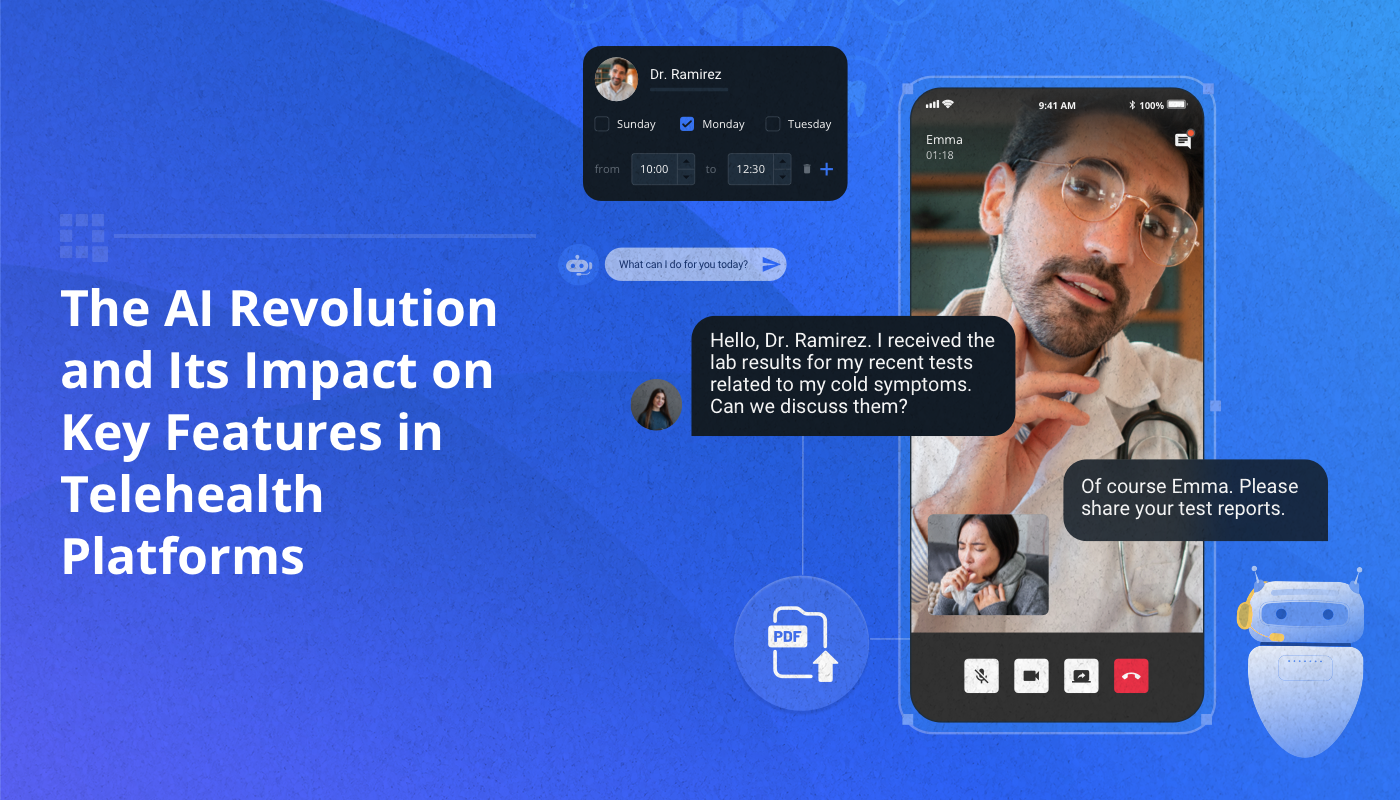
Summary: This blog explores the transformative influence of Artificial Intelligence (AI) on the key features in telehealth platforms. After providing a summary of the primary characteristics of telehealth systems, this blog will address both the promising advancements and potential disruptions that AI introduces to the telehealth landscape, offering readers a comprehensive understanding of the evolving intersection between technology and healthcare.
Introduction
Telehealth, a term that primarily evokes images of virtual consultations and remote patient monitoring, is now on the cusp of a transformational journey driven by the capabilities of AI. From redefining diagnostic accuracy to optimizing treatment plans AI has great scope to enhance the key aspects of virtual health platforms. However there are also concerns about the misuse of AI in a healthcare setting. This blog will highlight the ways in which AI is set to redefine the very fabric of telehealth, exploring the potential for enhancement, as well as the challenges and potential pitfalls that may arise.
Overview of Key Elements for Successful Telehealth
Telehealth platforms are dynamic ecosystems designed to bridge the geographical gap between healthcare providers and patients, offering a spectrum of services remotely. To comprehend the profound impact of AI on telehealth, it is imperative to first understand the fundamental features that define these platforms.
Virtual Consultations
Telehealth platforms enable real-time, virtual interactions between healthcare professionals and patients. This feature eliminates the need for physical office visits, providing a convenient and efficient means of healthcare delivery.
Remote Patient Monitoring
Facilitating continuous healthcare beyond the clinic, telehealth platforms incorporate remote patient monitoring capabilities. Wearable devices and sensors transmit real-time health data to healthcare providers, allowing for proactive management of chronic conditions.
Electronic Health Records (EHR)
Central to telehealth platforms is the integration of Electronic Health Records, ensuring seamless access to a patient’s medical history. EHRs facilitate comprehensive and accurate diagnoses, even in a virtual setting.
Prescription Management
Telehealth platforms often include features for e-prescriptions, streamlining the prescription and medication management process. AI can enhance this aspect by offering insights into medication interactions and personalized treatment plans.
Secure Communication Channels
Ensuring the privacy and confidentiality of patient information, secure communication channels are integral to telehealth platforms. Encryption and authentication protocols safeguard sensitive data exchanged during virtual consultations.
Appointment Scheduling and Reminders
Efficient scheduling and timely reminders contribute to the accessibility of telehealth services. These features enhance patient engagement and adherence to treatment plans while optimizing the overall healthcare delivery process.
Telehealth Apps and Portals
User-friendly interfaces, accessible through both web and mobile applications, form the foundation of telehealth platforms. These apps provide a seamless experience for both healthcare providers and patients, facilitating easy navigation and interaction.
Understanding the importance of these key features in telehealth platforms lays the groundwork for appreciating how AI advancements stand to enhance the very essence of telehealth platforms.
The Promise of AI Enhancement
AI is poised to enhance the primary characteristics of telehealth systems by ushering in a new era of precision and efficiency.
Enhanced Diagnostic Accuracy
AI algorithms, fueled by vast datasets and machine learning capabilities, have the potential to significantly elevate diagnostic accuracy in virtual health platforms. By analyzing symptoms, medical history, and even diagnostic images, AI can assist healthcare providers in reaching more precise and timely diagnosis. This promises a paradigm shift in the reliability of remote healthcare consultations.
Optimized Treatment Plans
Understanding the intricacies of individual patient profiles, AI can contribute to the optimization of treatment plans. By factoring in a patient’s medical history, genetic predispositions, and responses to previous interventions, AI-driven insights empower healthcare providers to tailor treatment strategies for better outcomes. This personalized approach holds the potential to improve the effectiveness of virtual healthcare delivery.
Predictive Analytics for Remote Patient Monitoring
Harnessing the power of predictive analytics, AI plays a pivotal role in remote patient monitoring, a primary characteristic of telehealth systems. By analyzing continuous streams of health data from wearables and sensors, AI algorithms can detect subtle changes in a patient’s condition, enabling early intervention and proactive healthcare management. This not only enhances patient outcomes but also reduces the burden on healthcare resources.
Streamlined Prescription Management
AI interventions in prescription management go beyond automating the process; they encompass a deeper understanding of medication interactions, potential side effects, and individual patient responses. By considering these factors, AI can assist healthcare providers in formulating more informed and personalized prescription plans, aligning with the key aspects of virtual health platforms.
Intelligent Appointment Scheduling
AI-driven algorithms can optimize appointment scheduling by analyzing historical data, predicting peak demand times, and accommodating the preferences of both patients and healthcare providers. This not only enhances the efficiency of telehealth platforms but also contributes to a more seamless and patient-centric experience, aligning with the primary characteristics of telehealth systems.
As we explore the promise of AI enhancement, it becomes evident that these advancements hold the potential to redefine the very essence of telehealth. By augmenting the primary characteristics telehealth platforms, AI opens doors to a future where remote healthcare is not just a viable alternative but a sophisticated and effective mode of healthcare delivery.
Challenges and Considerations
While the integration of AI promises transformative enhancements to key aspects of virtual health platforms, it also brings forth a set of challenges and considerations that necessitate careful examination.
Data Security and Privacy Concerns
The reliance on AI algorithms in telehealth platforms demands the extensive collection and analysis of sensitive patient data. Ensuring robust data security measures and compliance with privacy regulations becomes paramount. Striking a balance between utilizing patient information for AI-driven insights and safeguarding individual privacy poses an ongoing challenge.
Algorithmic Bias and Fairness
AI algorithms are only as unbiased as the data they are trained on. In the context of virtual health platforms, algorithmic bias may inadvertently lead to disparities in healthcare outcomes, impacting certain demographic groups more than others. Addressing and mitigating bias in AI models is essential to uphold the equitable delivery of telehealth services, aligning with the primary characteristics of telehealth systems.
Interoperability and Integration
Telehealth platforms often rely on diverse technologies and systems, and ensuring seamless interoperability poses a significant challenge. Integrating AI solutions into existing telehealth infrastructure requires careful coordination to prevent disruptions and maintain the key aspects of virtual health platforms, such as Electronic Health Records (EHR) accessibility and secure communication channels.
Regulatory Compliance and Standards
The rapid evolution of AI technology in healthcare often outpaces regulatory frameworks and standards. Achieving a balance between fostering innovation and ensuring patient safety requires proactive efforts in establishing and updating regulations. Compliance with healthcare standards is essential to maintain the integrity of telehealth systems’ primary characteristics.
User Trust and Ethical Considerations
Building and maintaining trust between patients and AI-driven telehealth platforms is a multifaceted challenge. Ensuring transparency in AI decision-making processes, explaining recommendations to patients, and addressing ethical concerns surrounding the use of AI in healthcare are crucial. Upholding ethical standards aligns with the key aspects of virtual health platforms centered around secure and trustworthy patient-provider interactions.
Using AI to Enhance Key Aspects of Telehealth Platforms
In the nexus of AI and telehealth, we witness a promising evolution that augments diagnostic precision, treatment personalization, and healthcare accessibility. While the integration of AI brings immense potential, it also necessitates a vigilant approach to address challenges like data security, algorithmic bias, and ethical considerations.
As we navigate this transformative landscape, it’s crucial to uphold the core principles of telehealth platforms. The path ahead requires collaborative efforts to ensure a seamless integration of AI while maintaining patient trust and privacy. For those seeking to build AI-integrated telehealth solutions, consider consulting with QuickBlox—an expert in crafting innovative and secure healthcare technology solutions. We offer a HIPAA compliant AI Assistant and an AI integrated healthcare consultation app. Contact us to learn.
Talk to a sales expert
Learn more about our products and get your questions answered.
Contact sales






